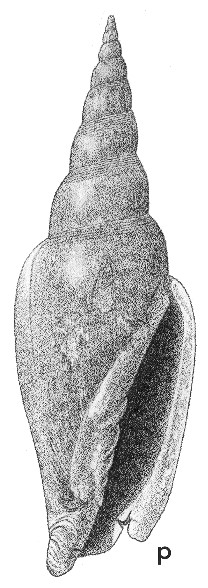
Revised descriptions of New Zealand Cenozoic Mollusca from Beu and Maxwell (1990)

 | Revised descriptions of New Zealand Cenozoic Mollusca from Beu and Maxwell (1990) | 
|
  (Pl. 25p): GS11211, D45/H82, Otahu Formation, left bank Waiau River, Clifden, Altonian (GNS) |
Beu & Maxwell (1990): Chapter 11; p. 230; pl. 25 p.
Synonymy: Clifdenia turneri Laws 1932, p. 196
Type species of Clifdenia Laws, 1932
Classification: Mitridae: Mitrinae
Description: Very large for family (height up to about 150 mm), fusiform, spire 0.45 total height. Protoconch unknown, but probably narrowly conical like many other mitrids. Teleoconch of about 10 whorls, early whorls gently convex, later whorls more strongly convex and turned in towards upper suture; last whorl contracted gradually, not excavated. Spiral sculpture of moderately strong, narrow cords on base of small shells, and much weaker ones below suture, the former becoming obsolete on large shells (greater than 60 mm), which are smooth and polished except for growth striae and feeble spirals. Aperture rather narrow, small shells without anterior notch, large shells strongly notched with a prominent, rounded fasciole. Columella almost straight with 4 or 5 plaits decreasing in strength anteriorly. Inner lip without definite callus on small shells but typically with prominent, spreading, shiny callus on large shells. Outer lip thin, smooth within.
Comparison: Clifdenia turneri is one of the most elegant and spectacular of all New Zealand Cenozoic gastropods. A closely similar form — separated as the subspecies C. turneri inflata by Grant-Mackie (1965) — is recorded from Pakaurangi Point (Otaian and Altonian); it differs in minor characters (e.g., in being relatively wider) from coeval Clifden shells, and may have been a true geographical subspecies. Laws (1932) referred Clifdenia to the Mitridae, but Cernohorsky (1970a, p. 61) placed it in the Volutidae. Maxwell (1992, pp. 134-135) commented on the ontogeny and relationships of C. turneri and other species, indicating that Clifdenia is a mitrid, probably descended from a species of Fusimitra Conrad, 1855, and the shell morphology (particularly the anteriorly decreasing columellar plaits) is much more like that of Mitridae than of Volutidae. Clifdenia is first definitely recorded from the Duntroonian (Chatton, Wendon Valley and Wharekuri) and is last known from the Kapitean of Te Araroa, East Cape. Fusimitra hectori (Bortonian-Kaiatan, North Otago and South Canterbury) (synonym Mitra mystica Suter, Bortonian, Kakahu; Maxwell 1992, p. 134) seems to have been an early member of the genus, and although it is much smaller and more slender than typical species, juvenile specimens of the Oligocene and Miocene species are very similar indeed to F. hectori, suggesting the derivation of Clifdenia from Fusimitra. A further complication is indicated by Maxwell's (2009, p. 245) inclusion of Eumitra(?) calcar (Marshall, 1918) (Beu &Maxwell 1990, p. 415) in "Clifdenia(?)" which, given its type locality of Pakaurangi Point, suggests that this is a juvenile specimen of (and so an earlier name for) C. turneri inflata.
Large American Neogene fossil specimens of Fusimitra illustrated by (e.g.) Maury (1917, p. 75, pl. 11, fig. 14, 14a; particularly Pilsbry 1922, p. 340, pl. 24, fig. 2; Mitra titan Gabb, 1873, Miocene, Dominican Republic; reaching at least 152 mm high) are remarkably closely similar to the New Zealand species previously assigned to Clifdenia, apart from most being narrower (although Pilsbry's illustration is almost identical). The Bortonian-Kaiatan and Kapitean species resemble typical Fusimitra species in shape, and it is only the Oligocene-Early Miocene species of the C. turneri group that are a little more inflated. It seems likely that Clifdenia is simply a synonym of Fusimitra.
Distribution: Altonian-Lillburnian; Long Beach Shellbed, Clifden, Altonian (type); Otahu Formation, Fouraye Siltstone, Calamity Point Sandstone and Lill Sand, Clifden, uncommon at all localities.
Cite this publication as: "A.G. Beu and J.I. Raine (2009). Revised
descriptions of New Zealand Cenozoic Mollusca from Beu and Maxwell (1990). GNS
Science miscellaneous series no. 27."
© GNS Science, 2009
ISBN
978-0-478-19705-1
ISSN 1177-2441
(Included with a PDF facsimile file
copy of New Zealand Geological Survey Paleontological Bulletin 58 in CD version
from: Publications Officer, GNS Science, P.O. Box 30368 Lower Hutt, New
Zealand)